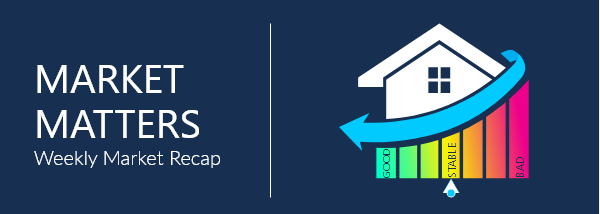Market Matters

This week we saw worse than expected initial jobless claims, while we continue to see stronger than expected home sales data. As we head into the end of September, the markets will continue to focus on round two of stimulus that Congress has not passed and a resurgence of virus cases in Europe. It may be too close to the November election to get a stimulus package passed, although, as new economic data comes in, it appears that additional stimulus could give the economy a boost.
 Initial Jobless Claims
Initial Jobless Claims
Initial Jobless Claims filed for the week ending September 19th rose by +4k to 870k from a previously revised print of 866k (orig. 860k). The 4-week moving average has now dropped down to 878.3k from a prior 913.5k. Continued claims, which lag a week, fell -167k to 12.58mln for the week of September 12th. The previous print of 12.628mln was upwardly revised to 12.747mln for the week of September 5th. Expectations are that we continue to see minor changes in the weeks ahead on headline.
 New Home Sales
New Home Sales
New Home Sales in August were up +4.8% to a seasonally adjusted annual rate of 1.011mln. July’s print was upwardly revised as well, printing now at 965k (+14.7%) from the original 901k (+13.9%). August now marks the fastest pace of new home sales since September 2006 when the rate was 1.016mln. The regional breakout shows sales rose by +5.0% in the Northeast, the South was up a strong +13.4%, the Midwest fell by -21.4%, and the West saw a drop of -1.7%. There were 282k unsold homes at the end of August, which is down -3.1% from the 291k in July. The time needed to clear that inventory at the current sales pace fell to 3.3 months in August, down from 3.6 months in July. Finally, and a bit puzzling, was the median sales price for a new home in August, which was down -4.6% to $312.8k from the median back in July of $327.8k. The August print is also down -4.3% YoY from August 2019’s $327.0k.
 FHFA House Price Index
FHFA House Price Index
The FHFA House Price Index for July revealed gains of +1.0% MoM, and now +6.5% YoY. The FHFA also revised it number for June from +.9% to now +1.0%. For July, the nine census divisions seasonally adjusted changes from June 2020 to July 2020 ranged from +.6% in the West North Central division, to +2.0% in the New England division. The 12-month changes ranged from +5.4% in the West South Central division, to +7.7% in both the Mountain and the East South Central divisions. National prices increased by over 2%, which is a 12.2% annual rate, in the last two months. This represents the largest two-month price increase since the start of the index back in 1991. As expected, the low interest rate environment, combined with the constrained supply of homes for sale, has been the driver of the recent price advances. Overall, the report suggests that the outlook for home price appreciation looks strong through September, however, housing affordability will most likely become more of an issue for buyers, regardless of how low mortgage rates go.
 Existing Home Sales
Existing Home Sales
Existing Home Sales rose +2.4% in August to a seasonally adjusted annualized rate of 6mln units. Sales are up +10.5% vs. August 2019, and this is the highest sales pace since December 2006. There were 1.49mln homes for sale at the end of August, which is down -18.6% annually and equals about a 3-month supply. This tighter inventory pushed the median home price in August to a record high of $310,600, which is up +11.4% YoY. “The imbalance of supply and demand will hurt affordability soon. Once that appears it will hinder home ownership rates,” said Lawrence Yun, chief economist for the Realtors. Regionally, the breakout for sales were strongest in the Northeast, up +13.8% MoM, while sales were +1.4% higher in the Midwest, and +.8% higher in both the South and West.

